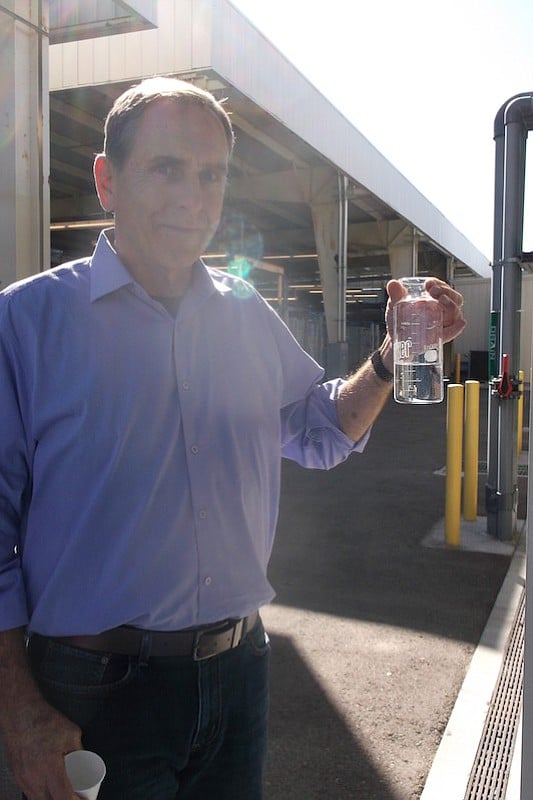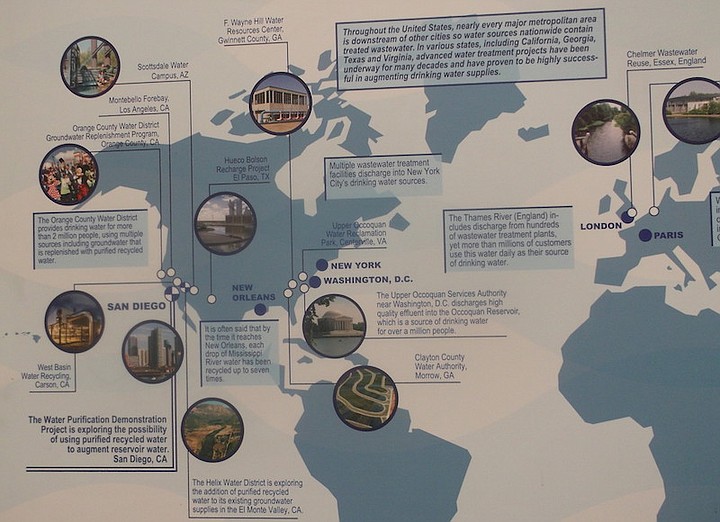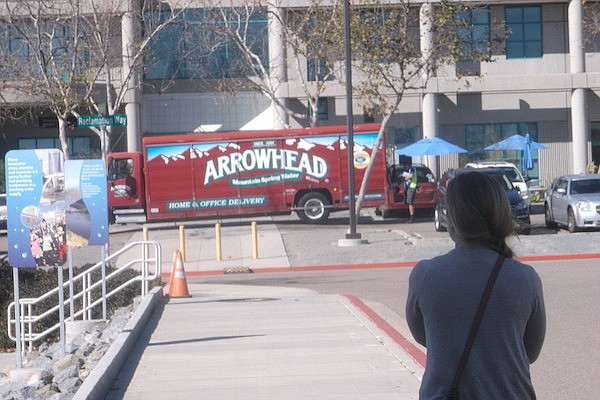 Facebook
Facebook
 X
X
 Instagram
Instagram
 TikTok
TikTok
 Youtube
Youtube

Sunlight sparkles through the water in the glass beaker biologist Jeff Pasek holds in his hand. The water has just been run out of the tap at the end of the city's pilot water purification plant.
Pasek leads the weekly tour of the water-reclamation plant in Miramar, where each week a dozen members of the public get a look at the city's pilot purification project.
We all taste the water and it tastes good — light and crisp and without minerals or a finishing tang that tap water has. It helps to have seen the equipment — the reverse-osmosis membranes, the ultraviolet blaster, and the massive tangles of filtration strands that it has been pushed through — and the multitude of monitors and test stations that check the purity of the water at each stage — before taking the leap of faith and drinking the water.
But it also helps that the water tastes good. It's flavor-free, lacking the chemicals that are added before it's pumped to your taps. Right now, the water — said to be cleansed to a purity that doesn't exist in nature — is being added to the purple pipe system of reclaimed water that's being supplied to parks, roadway medians, and golf courses. The pilot project, which has been producing one million gallons a day since August 2011 and has passed some 9000 quality tests, is going mainstream by 2021, with a 30-million-gallons-per-day plant being built near the test plant.

The most startling moment of the tour comes early, when Pasek produces a map that shows that most of our existing water supply has already been through someone else's toilet. More than half the city water supply comes down the Colorado River — into which about 400 wastewater plants near dozens of towns and cities, including Las Vegas, are discharging their treated sewer water, Pasek says.
In other words, our water supply is already recycled — experts estimate it has been recycled six or seven times before we tap into it.
The water supply we're tapped into isn't growing. And it's getting more expensive, Pasek says. That's partly because the price has been artificially kept low.
In 2000, water cost about $400 per acre-foot (enough water to cover an acre 12 inches deep); now it's $1200 per acre-foot and, by 2020, it will cost $2000 per acre-foot. As the price rises and the supply becomes less reliable, desalination and purification projects become a more realistic choice. The cost of extracting water from the ocean or the wastewater supply is about the same, Pasek says, and the largest part of the cost is for the energy used in the process.
Reverse osmosis, central to both approaches, relies on high-pressure pumps forcing the water through membranes that filter particles that are as tiny as 1/300th the thickness of human hair. At the end of the reverse osmosis is a shiny vat that resembles a space-age railroad tanker where the water is blasted with strong ultraviolet rays that destroy the DNA of any lingering microorganisms.
Once the plant is built and the water is approved — by the California Water Resources Control Board, the Division of Drinking Water, and the San Diego Regional Water Quality Control Board — the purified water will be sent to the San Vicente and Miramar reservoirs, where it will be mixed with imported water and rest for 30 days. That, Pasek says, will give the city a time buffer in case anything went wrong to go back and clean the water again.

Reservoir water is treated again before it gets into your tap, including adding chemicals to keep the water from leaching metals out of the pipes it is transported through.
In the meantime, no one is drinking the water except on the tour.
Which is why, at the end of the tour, an Arrowhead truck pulls up to the water reclamation building and unloads water-cooler-sized bottles of water.


Sunlight sparkles through the water in the glass beaker biologist Jeff Pasek holds in his hand. The water has just been run out of the tap at the end of the city's pilot water purification plant.
Pasek leads the weekly tour of the water-reclamation plant in Miramar, where each week a dozen members of the public get a look at the city's pilot purification project.
We all taste the water and it tastes good — light and crisp and without minerals or a finishing tang that tap water has. It helps to have seen the equipment — the reverse-osmosis membranes, the ultraviolet blaster, and the massive tangles of filtration strands that it has been pushed through — and the multitude of monitors and test stations that check the purity of the water at each stage — before taking the leap of faith and drinking the water.
But it also helps that the water tastes good. It's flavor-free, lacking the chemicals that are added before it's pumped to your taps. Right now, the water — said to be cleansed to a purity that doesn't exist in nature — is being added to the purple pipe system of reclaimed water that's being supplied to parks, roadway medians, and golf courses. The pilot project, which has been producing one million gallons a day since August 2011 and has passed some 9000 quality tests, is going mainstream by 2021, with a 30-million-gallons-per-day plant being built near the test plant.

The most startling moment of the tour comes early, when Pasek produces a map that shows that most of our existing water supply has already been through someone else's toilet. More than half the city water supply comes down the Colorado River — into which about 400 wastewater plants near dozens of towns and cities, including Las Vegas, are discharging their treated sewer water, Pasek says.
In other words, our water supply is already recycled — experts estimate it has been recycled six or seven times before we tap into it.
The water supply we're tapped into isn't growing. And it's getting more expensive, Pasek says. That's partly because the price has been artificially kept low.
In 2000, water cost about $400 per acre-foot (enough water to cover an acre 12 inches deep); now it's $1200 per acre-foot and, by 2020, it will cost $2000 per acre-foot. As the price rises and the supply becomes less reliable, desalination and purification projects become a more realistic choice. The cost of extracting water from the ocean or the wastewater supply is about the same, Pasek says, and the largest part of the cost is for the energy used in the process.
Reverse osmosis, central to both approaches, relies on high-pressure pumps forcing the water through membranes that filter particles that are as tiny as 1/300th the thickness of human hair. At the end of the reverse osmosis is a shiny vat that resembles a space-age railroad tanker where the water is blasted with strong ultraviolet rays that destroy the DNA of any lingering microorganisms.
Once the plant is built and the water is approved — by the California Water Resources Control Board, the Division of Drinking Water, and the San Diego Regional Water Quality Control Board — the purified water will be sent to the San Vicente and Miramar reservoirs, where it will be mixed with imported water and rest for 30 days. That, Pasek says, will give the city a time buffer in case anything went wrong to go back and clean the water again.

Reservoir water is treated again before it gets into your tap, including adding chemicals to keep the water from leaching metals out of the pipes it is transported through.
In the meantime, no one is drinking the water except on the tour.
Which is why, at the end of the tour, an Arrowhead truck pulls up to the water reclamation building and unloads water-cooler-sized bottles of water.
Comments